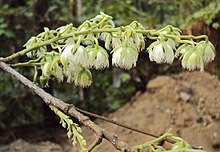Elaeocarpus serratus
| Elaeocarpus serratus | |
|---|---|

| |
| Scientific classification | |
| Kingdom: | Plantae |
| Clade: | Tracheophytes |
| Clade: | Angiosperms |
| Clade: | Eudicots |
| Clade: | Rosids |
| Order: | Oxalidales |
| Family: | Elaeocarpaceae |
| Genus: | Elaeocarpus |
| Species: | E. serratus
|
| Binomial name | |
| Elaeocarpus serratus Linnaeus, 1753 [1]
| |

Elaeocarpus serratus is a tropical fruit found in the Indian Subcontinent, Indo-China and South East Asia. It is an ornamental medium-sized tree indigenous to Sri Lanka, producing smooth, ovoid green fruits. The fruit has nutritive and medicinal values. This Ceylon olive is a beneficial herbal plant used to cure various diseases.
Taxonomy
The botanical name is Elaeocarpus serratus. Classified by Carl Linnaeus in 1753.[1] Belongs to genus Elaeocarpus and Family Elaeocarpaceae.
Distribution
It is an Asia-tropical fruit tree. Found in India - Karnataka, Kerala, Maharashtra, Tamil Nadu, Manipur, Assam and Nepal and Bangladesh and Sri Lanka in the Indian Subcontinent. Also found in Indo-China - Myanmar and Indonesia and Malaysia.[2]
In Sri Lanka the fruit is well known.[3]
It is called jolphai in Assamese, jalpai in Bengali, veralu in Sinhala, veralikkai in Tamil, kaarakka or kaara in Malayalam, chorphon in Manipuri and Ceylon olive or Indian olive or wild olives in English. The trees grow profusely in the Terai region of West Bengal, especially in districts like Jalpaiguri, Alipurduar and Cooch Behar.
Local names
Known as Veralu (වෙරළු) in Sinhala, Veralikkai in Tamil, Kaarakka or Kaara in Malayalam, Zolphai (জলফাই) in Assamese, Jalpai (জলপাই) in Bengali, Chorphon in Manipur and as Ceylon olive in English.[3]
Description
It is an ornamental medium-sized tree. Bears smooth ovoid green fruits[4] the size of about 2.5 cm long. Recommended varieties are local cultivars (round and oval fruits).[3] It has a brown coloured seed inside the fruit.The seed has a hard outer shell. The seeds are slow for germination and can take up to 2 years. The wood is whitish yellow.
Nutritive and medicinal values
The fruits are high in starch and sugar and have low amounts of protein and iron.[citation needed] It may help treat diarrhoea due to its constipating effect.[3][unreliable medical source?].
In Sri Lanka pickled Ceylon olives are eaten as popular street food.
References
- ^ a b Linnaeus, C. (1753) Species Plantarum, Tomus I: 515
- ^ "Elaeocarpus serratus". Germplasm Resources Information Network. Agricultural Research Service, United States Department of Agriculture. Retrieved 18 August 2011.
- ^ a b c d Department of Agriculture, Peradeniya, Sri Lanka, Task Force on Fruits & Fruit Development Board (1997). Tropical Fruits of Sri Lanka. Ministry of Agriculture and Lands, Sri Lanka. p. 29.
{{cite book}}: CS1 maint: multiple names: authors list (link) - ^ M.F.Macmillan (1989). Handbook of Tropical Plants. p. 560.
